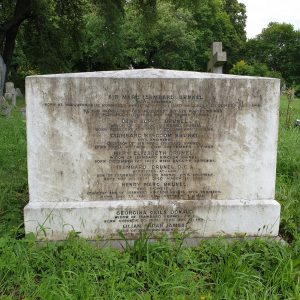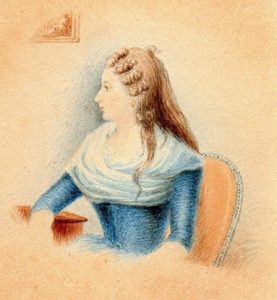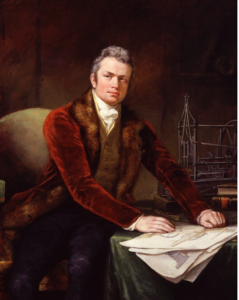March is #WomensHistoryMonth and we’re sharing the stories of women who made engineering history: from the lesser known Brunel women, trailblazing female engineers from the past or the women making history today with their feats of engineering.
Starting at the End
So, I’m going to start at the end, with the Brunel family gravestone, which you can visit yourself if you fancy a trip to Kensal Green cemetery) The Brunel family plot is on row one of square 41. It’s solid and plain, decorated only by the writing upon it.

It says:
“Sir Marc Isambard Brunel. Civil engineer. Born at Hacqueville in Normandy, April 25th 1769 : Died in London December 12th 1849. He has raised his own monument by his public works at Portsmouth, Chatham, and the Thames Tunnel.” Okay. So we know when and where he was born and died, what his career was, and some cool stuff he did. Great!
Next down is “Dame Sophia Brunel. Widow of Sir Marc Isambard Brunel. Born February 15th 1775 : died January 5th 1855.”
That’s it. Where was she born? What did she do? Other than at some point marry Marc and outlive him. Was that her greatest achievement?
Now, there are nine people buried on this unassuming plot, so many that not all the names would fit on the front of the gravestone and they started writing on the side.
For all the men, it says what their careers were. For the women, well, they were only worthy of note based on which man laid most claim to them. But who WERE they? Where did they come from? What did they achieve?

Possible picture of Sophia Brunel? (Private collection, used with permission.)
Early Life
Sophia Kingdom was the 16th child of William Kingdom and Joan Spry. William was a Plymouth Naval contractor. Sophia had a mix of older brothers and sisters.
Sophia’s father died when she was young*, and she passed into the care of her eldest brother along with a number of her other young siblings. At least one brother was a lawyer, one went into the navy, and one “held a post in Somerset House” (which at this point probably meant navy, though the Royal Academy of Arts, the Royal Society, and the Society of Antiquaries were also housed there at the time). Her sister Elizabeth married Thomas Mudge, who was the son of the Thomas Mudge who invented the lever escapement, a major feature of pocket watches from its invention in around 1757 well into the 1900s.
So Sophie grew up with her siblings in the care of her eldest brother.
When she was around 16, her brother decided to send her to France to learn French. Now, the French Revolution is underway at this point, but he apparently thinks that it’s only really Paris where that’s a problem, and if he sends her to Normandy, everything will be fine.

Travelling to France and Meeting Marc
So, on the 2nd December 1792, at 17 years old, Sophia gets onto a boat at Portsmouth for the two day journey to Le Havre. She travelled with a couple of friends, but when they arrived they realised the extent of the political unrest, and decided that it was not safe to be in France. They were quickly able to secure return passage, but Sophia had become ill on the journey so could not immediately return. Now, given that one of her brothers is listed as having died of sea-sickness, it may have been important to her not to get back on a boat right then!
So instead of returning to England, Sophia went to stay with the Carpentiers in Rouen.
23 year old Marc Brunel was recently returned from the navy and living with the Carpentiers (he was a cousin, I believe), though when Sophia arrived on the 14th of January 1793 he had been in Paris, getting into trouble by saying inadvisable things about Robespierre. He escaped from Paris only a day ahead of the barricades going around the city as Louis the XVI (16th)’s execution approached. (21st January.)
Marc got back to Rouen on the 17th of January, and insisted he fell in love at his first sight of Sophia. He kept diaries all his life, and rarely failed to celebrate that day. Unfortunately, Sophia does not seem to have kept diaries, and we don’t have Marc’s diaries from during their courtship. Likely because Sophia destroyed them upon his death – so young love gets to keep its secrets. And probably its embarrassingly bad poetry.
Mme. Carpentier urged propriety, but they were drawn to each other, and were young and impetuous. The violence in France was escalating. The next few months saw Sophia settled in at Rouen, but also saw frequent violent clashes on the streets. Marc was known to be a royalist, and was a somewhat outspoken and sarcastic young man, so was in very real danger. One night, after surviving a particularly dangerous riot, he abandoned his self-control and asked Sophia to marry him.
She agreed to the engagement, however the political situation was getting more fraught. It went from scuffles on the streets to bloody oppression, and you were risking arrest if you were even suspected of being royalist. Marc’s views were well known, so he realised he would definitely be arrested, and probably executed if he stayed. Attempting to flee, however, was seen as treason. The families of men who fled were punished and even musing about leaving was considered as bad as actually doing so.
The Terror
We’re now in summer 1793, the remaining French royals are imprisoned, and bread is scarce. Monsieur Carpentier has links to America and manages to obtain a passport for Marc on the pretext of going to New York to buy corn for the navy. Unfortunately, France has been at war with Britain since February, so there is no way to obtain a passport for Sophia. Marc sets sail on his two-month journey from Le Havre to America on July 7th 1793.
Sophia is therefore left stranded in France, without her fiancé or any way to return home. She stays with the Carpentiers, giving English lessons to daughters of local families to help pay towards her keep, and avoiding politics as much as possible.
In September The Terror began, the Jacobin leaders redoubling their violence against the loyalist enemy in their midst. Armed men might appear at any time, demanding at your door: “Open, in the name of the Nation!” Anything or nothing could make you a suspect.
In October 1793, the decree of the Convention went forth that all English of any sex should be arrested as spies and their papers and possessions confiscated.
Sometime that winter, the dreaded visit came, and Sophia, the English girl engaged to an escaped Royalist, was dragged away.
She was taken, several days travel in a crowded open cart, to Gravelines, a port about halfway between Calais and Dunkirk. Once there, she was imprisoned in a convent, because the ordinary prisons were so full no more victims could be forced inside.
Sophia used to tell her children about her time in the convent. The beds were wooden boards, with a double board for a pillow, and placed touching each other. The food was coarse bread mixed with straw, and there was never enough. She “always spoke of the kindness of the nuns, themselves prisoners and forced to wear secular clothes: and of how they taught her and the other women to make artificial flowers to distract their attention from the horrible sounds outside; the roaring of the mob, the clanging of the tocsin, and – worst of all – the rolling of the tambours that marked the fall of each head from the guillotine.” (Noble, 1938)
The Carpentiers made great efforts to secure her release. They collected testimonies from good republicans saying that she was of excellent character, and was teaching English to their families, an activity they hoped she would soon have the liberty to return to. However, none of these pleas worked, and Monsieur Carpentier was briefly detained himself, though released with no charges.
Summer drew on and Sophia’s companions at the convent were steadily taken away, those who remained living in daily expectation that madame guillotine would welcome them next.
Some time in the month known as Thermidor in the republican calendar, so in late July or early-mid August, the prison doors were set open and left open. No explanation was offered, and it took some time for the inmates to realise they were free to walk out. Robespierre had fallen, and the first action of the moderates was to unlock the prisons. (Bagust gives the date as the 24th July 1794, though information and action may have taken time to spread from Paris.)
Sophia managed to make her way back to Rouen and the Carpentiers, though it would be many months until she could obtain the necessary permissions to leave France. However, some time in 1795 a passport was procured, and she returned safely to England.
Marc in America
Whilst Marc was in America, he would occasionally write to Sophia, in one letter including a miniature painting of her from memory, along with one of him. In her widowhood she wore these in a locket, though the letters that accompanied them are gone. It is one of very few pictures of her.
Despite the attempt to stay in contact, he is unlikely to have known about her imprisonment until it was over. Sophia went back to living with one of her brothers, this time in London. She was attractive and cheerful and did not want for suitors.
Over the years he was in America, Marc had a much more enjoyable time, moving in important circles and gaining renown as an engineer. He came up with a much improved way to make blocks for tackle for naval ships (the start of the idea apparently coming to him at a dinner with founding father Alexander Hamilton, the rest of the plan whilst carving Sophia’s initials into a tree).
Reunion
He had a good idea, a letter of recommendation, and a strong desire to see Sophia.
How do we know that she was his top priority? There is some argument regarding exact date and place of landing, but he likely landed at Plymouth on the 13th March 1799. He went from there to London, reaching London on the 16th and immediately meeting with Sophia’s brother at Somerset House to be reunited with her.
Her great granddaughter recounts that “The lovers used to tell, in after years, of the shock to them both of that first meeting, when each found the other so changed as to be quite unrecognisable.” This did not, however, weaken their devotion to each other. Her family were not particularly pleased with her choice of a Frenchman, but as she had spent four years turning down all other offers, they accepted with the best grace they could muster.
Wasting little time, they were married in Sophia’s parish church of St Andrew’s, Holborn, on November 1st 1799.
Their marriage, despite the family’s mixed fortunes, seems to have been a happy one, and there are accounts of the couple scandalising society by being obviously affectionate and in love.
Portsea and a Growing Family
They settled in Portsea, where Sophia had a brother who was a naval agent and offered to help Marc convince the navy of his blockmaking plans.
However, the current suppliers, the Taylor family, were uninterested in changing their methods and rebuffed him. Now, it’s not necessarily connected, but according to family gossip, one of the suits that Sophia had spurned was that of Walter Taylor.
At Portsea their three children were born. The eldest was a daughter, who they named Sophia. She was born in 1802 (died 1878) and at 18 married Sir Benjamin Hawes, who was to become Under-Secretary of State for War and M.P. for Lambeth. She is described as being “a remarkably talented woman who understood her father’s and brother’s plans” and was called by Lord Armstrong “Brunel in petticoats”.
The second child was Emma, born around 1804. In her early 30s she married Revd. Frank Harrison, and she likely died in 1875. She is sometimes referred to in family correspondence as “poor Emma”, was often ill and suffered from nervous headaches.
On the 9th of April 1806 their only other child to survive to adulthood was born, Isambard Kingdom Brunel. Who went on to marry Mary Horsley in 1836, and who dies in 1859, though you probably all know rather more about him than that!
The Misfortune
The blockmaking was a success, though the government avoided paying a fair price. Between that and issues with other endeavours, the family fortunes were rather variable. They ran out of money and, in 1821, (the year after the younger Sophia was married) Marc was committed to the King’s Bench Prison in Southwark for debt. In later years this episode was referred to by the family as “The Misfortune”. It sounds odd today, but Sophia, “as a good wife did in such cases”, chose to accompany him to prison, “and for two months shared his confinement”. In the small gloomy rooms of the prison (think a bigger version of Marshalsea Prison, if you have ever read Charles Dickens’ Little Dorrit) they tried to find a way to get back on an even keel. Marc wrote many letters to his friends, looking for help.
Neither Marc nor Sophia does well during this imprisonment. In a letter to Lord Spencer, he writes “My affectionate wife and I are sinking under it”. “We have neither rest by day nor night.” In a letter to Sir Edward Codrington he writes of Sophia “her health, I fear, is sinking for the want of those comforts which we have now lost.” However, in another letter, to Dr Woolaston, he writes about himself “I am at present so completely overcome as to be at times alarmed as to the state of my nerves. Nothing but the fortitude of my dearest Mrs. B that supports me at all.”
Nothing really moved forward until he opened correspondence with Alexander of Russia, who he had met and been offered employment by when the Tsar had come to marvel at his blockmaking machinery. It became apparent that the family had options to leave the country, and something had to be done if they were to be kept. The government granted some of what Marc was owed, and he was released.
London and the Tunnel
He threw himself back into work, and things went well for a while. They moved around as Marc’s projects required, moving from Lindsay Row in Chelsea to the somewhat looked down upon area of Blackfriars when work on the Thames Tunnel started, in order to be nearer the works.
When Isambard was injured building the tunnel, Sophia moved in with him for a little while to look after him, before he went to Brighton, then Bristol, to recuperate.
An acquaintance of just after this time, the author Charles Macfarlane, describes meeting Sophia “I was not ten minutes in her company before I made out that she was devotedly attached to her dear old French husband”.
The tunnel project was long and stressful. In the second phase, when tunnelling reopened after the long break, Marc and Sophia would get up in the early hours of the morning. She would wrap him up and light his lamp, and he would go down to the works for an hour or two.
That is until, in June 1839, when he got up at quarter past two, but wrote happily in his diary that he didn’t have to go down to the site, because he “found the report for the night in my new Box of Mrs. Brunel’s contrivance, whereby I obtain my notes in my bedroom – dear Sophia!” This refers to an arrangement by which a bell rang near the bed, he then knew to pull up a basket to the window from outside, that would contain the foreman’s report and a sample of the last excavated soil; after examining it, he wrote his instructions and sent them down by the same means. This examination of the ground took place every two hours, day and night, for at least 4 years. Later in life, when the old couple sat together telling their reminiscences to the younger generation, a favourite description of Sophia’s was of their waking together, their difficulty at first in going to sleep before it was time to wake again, and then, after the habit had been acquired, of their continued waking every two hours for many months after the tunnel had been finished.
When Marc first breaks through with the Thames tunnel, he writes “Rotherhithe, August 12, 1841. Just returned from Wapping by land at two p.m. These are the first lines I have laid on paper of this event, and to my dearest Sophia, I owe this triumph.” And later “Sans toi, ma chère Sophie, point de Tonnelle” which translates as ‘Without you, my dear Sophie, no Tunnel’.
If you would prefer to listen to this article, please use the player below.
_________________________________________________________________
[Note: Tonnelle is usually translated as ‘arbour’, but is also a doublet of tunnel, a re-borrowing from English.]
* The first version of this stated that Sophia became an orphan young, per several books that mention her. However, further research has shown that her mother likely survived until 1807, though details are still being researched.
_____
If you want to keep up to date with Brunel Museum news, please check out our News page and follow us on Social Media:
Connect with us on Bluesky / Facebook / LinkedIn / YouTube / Instagram You can also sign up to our newsletter here.
If you enjoyed this article, please Donate to the Brunel Museum .
